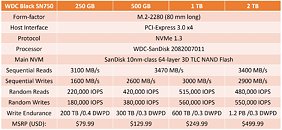Monday, January 21st 2019

Western Digital WD Black SN750 is a High-end NVMe SSD with a Chunky Heatsink
Western Digital over the weekend refreshed its high-end client-segment SSD lineup with the WD Black SN750. Built in the M.2-2280 form-factor with PCI-Express 3.0 x4 interface and support for the NVMe 1.3 protocol, the drive combines a refreshed in-house developed controller with SanDisk-made 64-layer 3D TLC NAND flash memory, cushioned by up to 2 GB of DRAM cache. The biggest change this drive offers over last Summer's WD Black 3D series, however, is the optional aluminium heatsink originally made by EK Waterblocks, which improves the drive's thermals and possibly sustained performance. You can opt to buy the drive without this heatsink.
Available in capacities of 250 GB for $80, 500 GB for $130, 1 TB for $250, and 2 TB for $500, the WD Black SN750 offers sequential transfer rates of up to 3470 MB/s reads on the 500 GB and 1 TB models. The 250 GB model reads at up to 3100 MB/s, and the 2 TB model up to 3400 MB/s. Sequential write speeds, too, are improved across the board, with up to 3000 MB/s for the 1 TB model, up to 2900 MB/s for the 2 TB model, up to 2600 MB/s for the 500 GB model, and up to 1600 MB/s for the 250 GB model. 4K random-access numbers can be as high as 515,000 IOPS reads. All models are backed by 5-year product warranties.
Available in capacities of 250 GB for $80, 500 GB for $130, 1 TB for $250, and 2 TB for $500, the WD Black SN750 offers sequential transfer rates of up to 3470 MB/s reads on the 500 GB and 1 TB models. The 250 GB model reads at up to 3100 MB/s, and the 2 TB model up to 3400 MB/s. Sequential write speeds, too, are improved across the board, with up to 3000 MB/s for the 1 TB model, up to 2900 MB/s for the 2 TB model, up to 2600 MB/s for the 500 GB model, and up to 1600 MB/s for the 250 GB model. 4K random-access numbers can be as high as 515,000 IOPS reads. All models are backed by 5-year product warranties.


21 Comments on Western Digital WD Black SN750 is a High-end NVMe SSD with a Chunky Heatsink
The retail price of the previous gen Black is lower though.
Sadly the Optane drives are unobtanium for most normal people...
But yes, this is where we need to see improvements now, as the sequential performance is at a point where any more gains are mostly pointless.
It does look like the new PCIe 4.0 controllers, based on the single point of reference from CES, have improved 4K performance as well, if only slightly and mostly on the write side.
www.phison.com/en/company/newsroom/press-releases/general/971-consumer-electronics-show-2019_en
Admittedly that's for a 250GB drive, so we might see slightly better numbers with more NAND. They're not using the default test settings though, so the numbers are a bit skewed.It helps reduce throttling over time, so for long writes, it should do something, assuming there's enough air circulation around the SSD and it's not underneath your graphics card. It also looks cool, no? :p$250 MSPR is sky high for a 1TB NVMe drive? I guess we have different opinions about sky high pricing then.
www.tweaktown.com/reviews/8490/intel-760p-512gb-2-nvme-pcie-ssd-review/index5.html
Each to their own I guess.You can't compare CrystalDiskMark 3.x and 6.x numbers, they're not apples to apples comparable.
There are faster PCIe 3.0 drives out there, but all of them will run hot - while some run super hot, though we will need PCIe 4.0 to break 10GBps mark for a single drive.
no cooler
m.2 shield
basic passive heatsink (aquaccomputer m.2 micro)
a quality m.2 heatsink (m.2 evo)
and yet very similarly priced with the same endurance